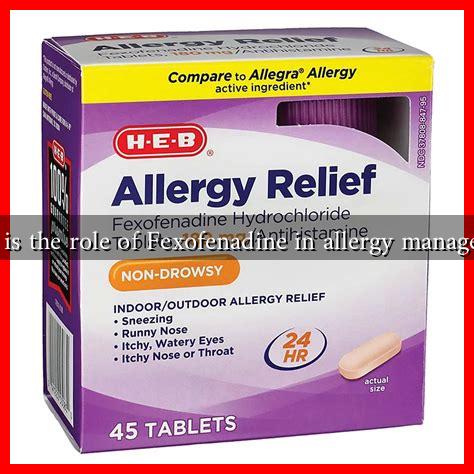-
Table of Contents
The Role of Fexofenadine in Allergy Management
Allergies are a common health issue affecting millions of people worldwide. They can manifest in various forms, including hay fever, food allergies, and skin reactions. Managing these allergies effectively is crucial for improving the quality of life for those affected. One of the most widely used medications for allergy relief is Fexofenadine, an antihistamine that has gained popularity due to its efficacy and safety profile. This article explores the role of Fexofenadine in allergy management, its mechanism of action, benefits, and considerations for use.
Understanding Fexofenadine
Fexofenadine is a second-generation antihistamine primarily used to treat allergic rhinitis and chronic urticaria (hives). It works by blocking the action of histamine, a substance in the body that causes allergic symptoms. Unlike first-generation antihistamines, Fexofenadine is less likely to cause sedation, making it a preferred choice for many patients.
Mechanism of Action
The effectiveness of Fexofenadine lies in its ability to selectively inhibit peripheral H1 receptors. This action prevents histamine from binding to these receptors, thereby reducing symptoms such as:
- Itching
- Runny nose
- Sneezing
- Watery eyes
By targeting these symptoms, Fexofenadine provides relief without the sedative effects commonly associated with older antihistamines.
Benefits of Fexofenadine in Allergy Management
Fexofenadine offers several advantages in the management of allergies:
- Rapid Onset of Action: Fexofenadine typically begins to work within one hour of ingestion, providing quick relief for allergy sufferers.
- Long Duration of Effect: The effects can last up to 24 hours, allowing for once-daily dosing, which enhances patient compliance.
- Minimal Sedation: As a second-generation antihistamine, it is less likely to cause drowsiness, making it suitable for individuals who need to remain alert.
- Wide Availability: Fexofenadine is available over-the-counter in many countries, making it easily accessible for those in need of allergy relief.
Case Studies and Statistics
Research supports the efficacy of Fexofenadine in managing allergic conditions. A study published in the Journal of Allergy and Clinical Immunology found that patients taking Fexofenadine experienced a significant reduction in allergy symptoms compared to those receiving a placebo. Additionally, a survey conducted by the American College of Allergy, Asthma, and Immunology revealed that over 70% of patients reported satisfaction with Fexofenadine as their primary allergy medication.
Considerations and Side Effects
While Fexofenadine is generally well-tolerated, some individuals may experience side effects, including:
- Headache
- Dizziness
- Nausea
It is essential for patients to consult with healthcare providers before starting Fexofenadine, especially if they have pre-existing health conditions or are taking other medications. Additionally, individuals with severe allergies should consider comprehensive allergy testing and management plans that may include immunotherapy.
Conclusion
Fexofenadine plays a vital role in allergy management, offering effective relief from symptoms with minimal side effects. Its rapid onset, long duration of action, and low sedation risk make it a preferred choice for many individuals suffering from allergies. As with any medication, it is crucial to use Fexofenadine under the guidance of a healthcare professional to ensure optimal results and safety. With the right management strategies, individuals can lead a more comfortable and fulfilling life, free from the burdens of allergy symptoms.




